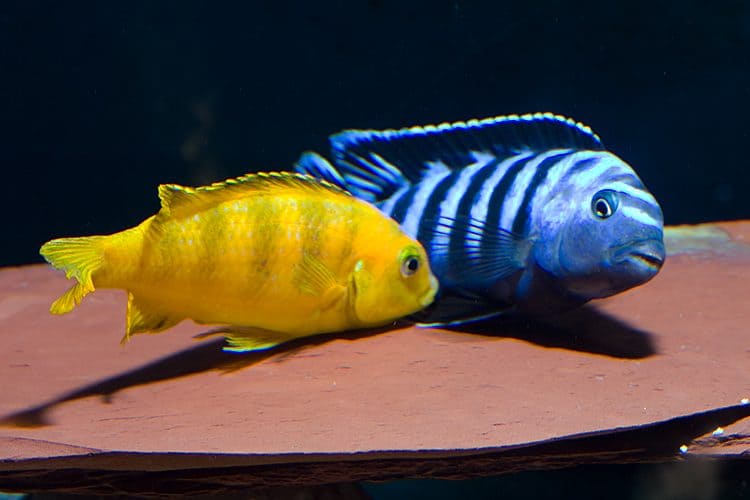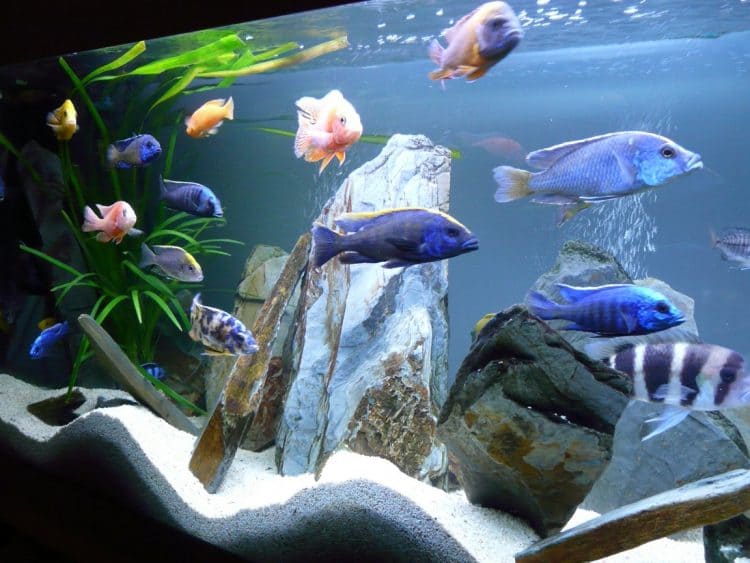The first thing that I have to point out is that I’m not an expert on cichlids by anyone’s definition, but I do consider myself to be an enthusiastic hobbyist who is lucky enough to be having my fair share of success.

I first started keeping cichlids about two years ago after about two years of keeping tropicals. I also joined the Cichlid Society about two years ago. My first success with breeding cichlids was about 18 months ago when I bred my first Pseudotropheus hajomaylandi. This was partly due to a lot of good advice I received from other members – mainly committee members. So, when Sabine Wilkins asked me to give a talk at the Society’s April meeting I decided that it was time to put something back into the club, so I agreed.
I only have ten tanks for a total capacity of less than 1700 litres (370 gallons). My largest two tanks are 300 litres each. So far I have managed to breed nine species of cichlids:
ˇ Pseudotropheus hajomaylandi ˇ Sulphur crested lithobates (Otopharynx lithobates) ˇ Electric blues (Sciaenochromis fryeri) ˇ Electric yellows (Labidochromis caerulus) ˇ Placidochromis electra ˇ Pseudotropheus perspicax ˇ Tropheus moorii (Ikola, Kaiser I Tropheus) ˇ Aulonocara baenschi and the fish that I gave my talk about: ˇ Pseudotropheus saulosi
The first saulosi that I ever saw were in a display tank at TLC Aquarium. That was back in December 1998. Aiden owned TLC then and he had two pair of saulosi in a 3 foot tank. Aiden had bought them from Steve Thompson of the Illawarra Branch of the NSW Cichlid Society and intended to keep them for breeding.
In my opinion saulosi are beautiful little fish. They are a Lake Malawi mouth brooder and they get to about 9 cm in length. The males are mid-blue with vertical black bars and black fins, usually with only one large egg-spot on the anal fin. The females are an orange yellow colour and are slightly smaller than the males – about 8cm. The fry and juveniles are the same colour as the females. The males change colour at about four to six months old.
Pseudotropheus saulosi were named after Saulos Mwale, a fish catcher who works for Stuart Grant on Lake Malawi. I hope that I might get to meet Saulos when I go on Rod Wallace’s trip to Africa later this year. Saulosi are endemic to the Taiwan Reef area of the Lake. They live amongst the huge boulders at the reef at a depth of between 5 and 20 metres. They were first exported from Lake Malawi in the early 1990s. I don’t know when they first came to Australia but probably not much before 1996.
Saulosi are omnivorous, in the wild they feed from the biocover where they pick and nibble the loose material from the substrate. I feed mine twice a day with a mixture of flake and pellets with an occasional treat of frozen daphnia.

A week or so after I first saw the saulosi at TLC I made two very smart moves – I talked my wife into letting me spend $100 on a pair of fish and I talked Aiden into taking my money from me. These fish had bred for Aiden in the shop and he had some fry for sale. I bought four fry about two weeks after I bought the adult pair. And then, another two weeks later, I talked Aiden into selling me his second adult pair.
The two pairs had been living together quite happily in the tank at TLC, but when I introduced the second pair into my tank at home I saw for the first and only time that these beautiful little fish can be very aggressive. The original male chased the new male from the moment I put them together. After five minutes I moved both pairs to another tank so that neither of them had an established territory and the chasing stopped. But the next morning I found the new male dead.
I was left with a male, two females and three fry (one died). I put them in a standard 3 foot tank with three bristlenose catfish. Ad Konings recommends a minimum tank size of 150 litres, my 3 foot tank is only 130 litres but the saulosi seem happy enough in that size tank. I have a few rocks formed into caves, but the fish seem happy enough swimming about in open water most of the time. They are usually visible and active, which makes them a more attractive fish to keep.

Nine of my ten tanks are set up for Lake Malawi conditions. I try to keep the water conditions the same in all nine tanks to minimise shock when I have to move fish around. I use Seachem cichlid salt and Lake Malawi buffers. I keep the pH between 7.8 and 8.0, the carbonate hardness at about 150 ppm and the temperature at 27 degrees. The pH may be a little on the high side, and that probably accounts for me getting a high proportion of male offspring, but that’s the pH result that I get using the Seachem products.
The tank is filtered by a Penguin 160 Bio-wheel and the tube type under-gravel filter. I have found that the tube type doesn’t clog or allow a build-up of rubbish like the plate types. I don’t have any real problems with the under-gravel tubes being exposed by digging. I do a 25% water change every three weeks. I know that this scares a lot of people who are doing a 10% change every week, or even bigger changes more often. But it works for me on all of my tanks and if it works why change it?
Apart from having a big enough tank and the right water conditions I have found, with all of my breeding tanks, that it is important to provide a suitable spawning site. For my mouth brooders I build a cave in a corner of the tank. The cave seems to work best if it has a flat rock on the bottom and another flat rock as a roof. The top rock is supported by two or three other rocks and the distance between the top and bottom rocks obviously has to be greater than the height of the fish. I have seen fish spawning on large flat rocks out in the open and so many eggs are lost to hungry tank-mates. The cave provides the male with a better chance of defending the spawning site during mating.
I got my first spawn of seven fry on the 26 February, two months after I bought the first pair. I strip the females of free swimming fry 14 days after spawning. The females usually take about six weeks to recover and spawn again after stripping but I have one that recently only took two weeks to spawn again and produced twelve fry. The females, like most mouth brooders, stop eating when holding eggs. But I have seen females sucking in tiny bits of flake after about 10 days. I don’t know if this is for themselves or for the fry that they are holding. I’ve seen my Tropheus start picking at algae in the tank after holding for about three weeks. I think that this is how they introduce real food to their fry. It might be the same for saulosi.
The size of spawns that I have got has ranged from 1 to 25 fry, the average size spawn is about 12 to 15 fry. The fry take about 8 to 10 weeks to get to a saleable size of about 3 to 4cm.
I said that I strip the females of free swimming fry 14 days after spawning. I recently had two females that spawned 3 days apart, so rather than pull the rocks out and disturb the tank twice, I decided to let one go for 15 days and do the other one at the same time – 2 days early. I fed the fish in the morning and both females were still holding and came home that night to strip them. The one that had been holding for 15 days had spat in the tank during the day and all the fry had been eaten, bar one that I noticed a week later. Very disappointing!
I have found that the composition of the colony is another very important factor in successful breeding. I recently had a problem where my females suddenly started spitting or swallowing their fry after about 3 or 4 days. At first I couldn’t work out what was different and what the problem was. I lost about eight mouthfuls before realised what the problem was. One of the original fry that I bought had grown into a beautiful full-sized male. He was subdominant to my original male and, although the two lived together in apparent harmony, he was not allowed to breed with any of the females. Every time a female got a mouthful this subdominant male would harass them until they either spat or swallowed their eggs. I moved the subdominant male to another tank and the females immediately began to hold full-term again.
Another problem that I thought I had some time ago was that one of my original females turned from the usual orange yellow colour to light blue. I thought that this could have been some sort of genetic problem but, at his recent talk about his fish room, Domenic Ruggiero said that occasionally a female saulosi will turn a light blue colour. So I guess that I didn’t have a problem at all.
There are quite a few more saulosi around now than there were twelve months ago, but they seem to hold their value. A friend told me that he saw 4 cm juveniles at a number of aquariums, a week or two ago, for $35 each.
As I have said, I think that saulosi are beautiful little fish. Their colours, visibility and activity make them a very attractive and enjoyable fish to keep. I would recommend them to anybody.

What other African Cichlids would you recommend being compatible and best compliment the ps saulosi? Or are they best to do a colony?